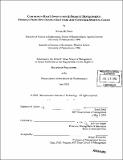| dc.contributor.advisor | Eric von Hippel. | en_US |
| dc.contributor.author | Shah, Sonali K., 1974- | en_US |
| dc.contributor.other | Sloan School of Management. | en_US |
| dc.date.accessioned | 2005-08-24T22:43:43Z | |
| dc.date.available | 2005-08-24T22:43:43Z | |
| dc.date.copyright | 2003 | en_US |
| dc.date.issued | 2003 | en_US |
| dc.identifier.uri | http://hdl.handle.net/1721.1/8004 | |
| dc.description | Thesis (Ph. D.)--Massachusetts Institute of Technology, Sloan School of Management, 2003. | en_US |
| dc.description | Includes bibliographical references (p. 209-219). | en_US |
| dc.description.abstract | Academics and practitioners have long been interested in understanding the sources and causes of innovative activity and the relationship between innovation and industrial change. Existing theory assumes innovative activity to be the domain of firms and research institutions, and commercial activity to be the domain of firms and entrepreneurially-minded individuals. Work in this tradition finds it difficult to explain the emergence of new fields and technological trajectories. This thesis suggests and provides evidence for the idea that social activity may precede and heavily influence both firm and market formation via the innovative activities that take place within user "communities." "Communities" are composed of loosely-affiliated individuals with common interests. They are characterized by a lack of formal coordination and the free flow of information. These characteristics allow for rich information and feedback and the matching of problems with individuals who possess the ideas and means to solve them. Due to the varied skills and needs of the individuals involved, user communities are well-equipped to identify and solve a wide range of design problems. The "many hands" of communities act as an innovation development and selection process operating largely independent of the visible hands of firms and the invisible hand of markets. Each essay in the thesis investigates the impact of community-based innovation and product development process on a different level. Essay 1 discusses the impact of user-innovators and their communities on firm and industry formation; Essay 2 examines the inner-workings of four formally-organized communities; Essays 3 and 4 discuss the individual-level motivations that drive community participation. Evidence is drawn from three unique data sets in the fields of commercial sports equipment and software. | en_US |
| dc.description.statementofresponsibility | by Sonali K. Shah. | en_US |
| dc.format.extent | 219 p. | en_US |
| dc.format.extent | 16635140 bytes | |
| dc.format.extent | 16634900 bytes | |
| dc.format.mimetype | application/pdf | |
| dc.format.mimetype | application/pdf | |
| dc.language.iso | eng | en_US |
| dc.publisher | Massachusetts Institute of Technology | en_US |
| dc.rights | M.I.T. theses are protected by copyright. They may be viewed from this source for any purpose, but reproduction or distribution in any format is prohibited without written permission. See provided URL for inquiries about permission. | en_US |
| dc.rights.uri | http://dspace.mit.edu/handle/1721.1/7582 | |
| dc.subject | Sloan School of Management. | en_US |
| dc.title | Community-based innovation & product development : finding from open source software and consumer sporting goods | en_US |
| dc.title.alternative | Community-based innovation and product development | en_US |
| dc.type | Thesis | en_US |
| dc.description.degree | Ph.D. | en_US |
| dc.contributor.department | Sloan School of Management | |
| dc.identifier.oclc | 53483995 | en_US |
